Creating a naturalistic planted vivarium is one of the best things you can do for your pet reptiles.
Who wouldn’t want to be surrounded by lush green foliage?
That said, the appetite of your pet critters can make plant choices a little more complicated. It’s important that we choose non-toxic plants just in case they have a curious bite.
But we also want to have interesting and aesthetic plants that are going to grow well too!
So for this guide, we’re covering the best safe plant for reptiles, that can thrive in terrarium conditions (and look good doing it).
Let’s go!

Terrarium Tribe is reader-supported. When you purchase through links on our site, we may earn an affiliate commission (at no further cost to you). 💜
How to Choose Plants Safe for Reptiles
Reptiles come in all shapes, sizes, and wonderful species – there’s no one-size-fits-all diet here.
Of course, there are many reptiles that are happily carnivorous and have no real interest in a plant-based diet. But, there are a few omnivores that seem to enjoy a side salad (or at least like to nibble on the occasional vivarium plant).
It’s generally better to be safe than sorry when it comes to our precious pets.
I value curiosity as a trait in people and animals alike, and I don’t want any reptiles being harmed just for being adventurous eaters!
So, for the purposes of this list, we’re sticking to non-toxic plants only.
That said, I can’t personally confirm the safety of each plant for every reptile species. I don’t keep reptiles and it’s not exactly ethical to perform food safety tests at home…
That’s why it’s important to do your own due diligence using trusted sources that have their own research and experience.
So, for this list, I’ve used the Tortoise Table’s database to get the most up-to-date information. Every plant below has been labeled as “safe” or “feed in moderation” by the experts there.
There can be a lot of conflicting information on the web, so to be extra safe, you can also cross-reference against the individual plant pages on Josh’s Frogs to see if they have a tick by “Lizards and Turtles.”
All that aside, I’ve picked out a selection of fantastic plants that can all work amazingly well in tropical vivariums.
Ready to see them? Let’s do it.
The Best Reptile Safe Plants – Our Top 10 Picks
- Boston Fern (Nephrolepis exaltata)
- Snake Plant (Dracaena trifasciata)
- Neoregelia Bromeliad
- Aluminum Plant (Pilea cadierei)
- Sphagnum Moss
- Nerve Plants (Fittonia)
- Inchplant (Tradescantia zebrina)
- Rattlesnake Plant (Calathea lancifolia)
- Peperomia caperata ‘Rosso’
- Herringbone Plant (Maranta leuconeura)
Next, we’ll deep dive into each of these reptile safe plants (with pictures), and we’ll add some more great plants into the mix.
1. Boston Fern (Nephrolepis exaltata)
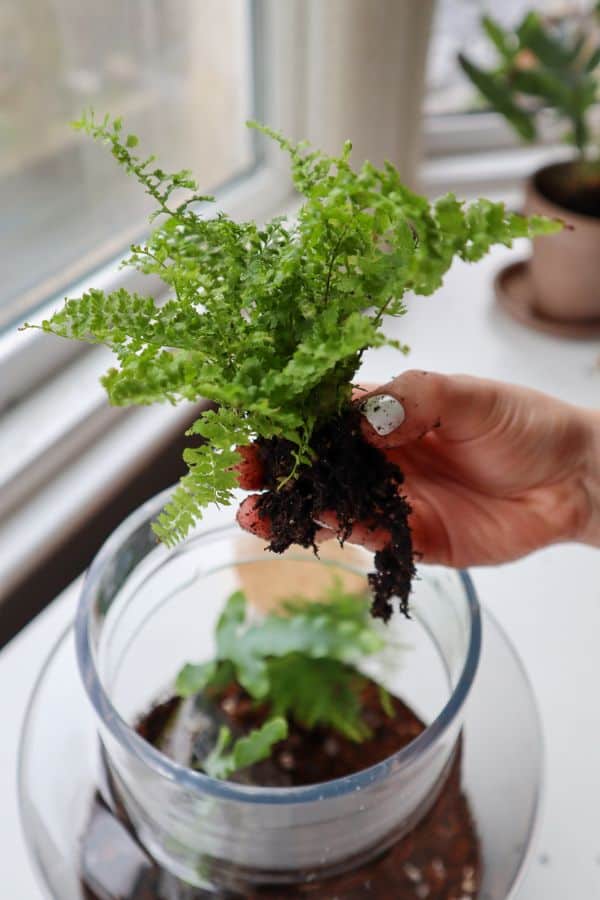
The Boston Fern is a classic sword fern that’s full of character.
Prized for their large textured fronds that spill out in an arching fashion, they’re a fantastic way to add some natural texture to a terrarium.
These ferns can get fairly big, but they do tend to grow fairly slowly.
You can always choose one of the dwarf versions, e.g., Nephrolepis exaltata ‘Fluffy Ruffles’ for smaller enclosures (yes, it’s every bit as adorable as it sounds).
As far as ferns go, sword ferns are reasonably tough and should hold up well in a reptile terrarium. An easy pick as far as I’m concerned!
2. Snake Plant (Dracaena trifasciata)
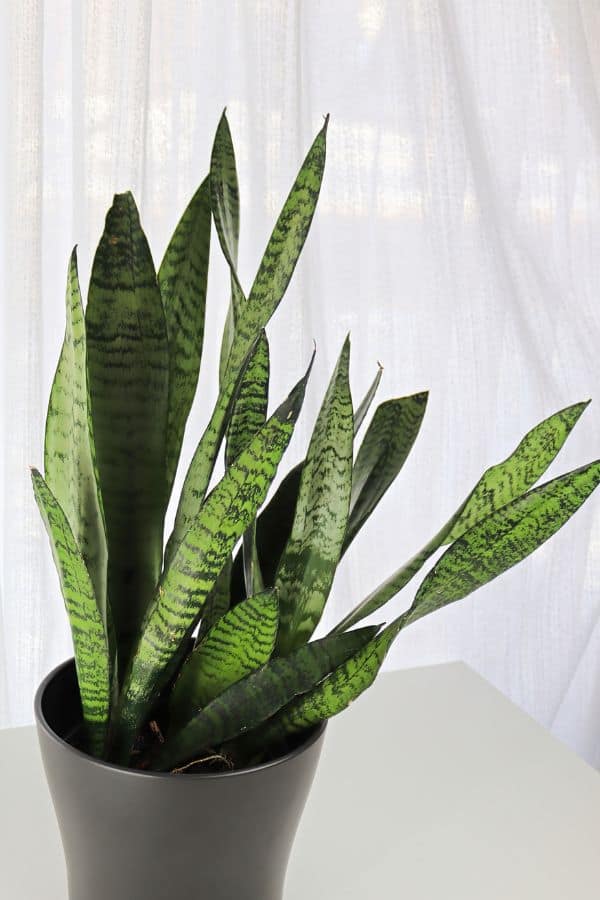
These bulletproof plants are a mainstay houseplant around the world, but they make a solid choice for reptile enclosures too.
As a tropical succulent, the Snake Plant is right at home in both tropical and arid environments.
So, this versatile number can work in just about any situation.
These guys are hardy when it comes to environmental conditions, but they’re physically hardy too.
Seriously, the tall, thick leaves are even strong enough to support a variety of smaller climbing species.
Which is handy because these things grow super tall. So they’re almost certainly best for enclosures housing arboreal species that like to climb.
3. Neoregelia Bromeliads
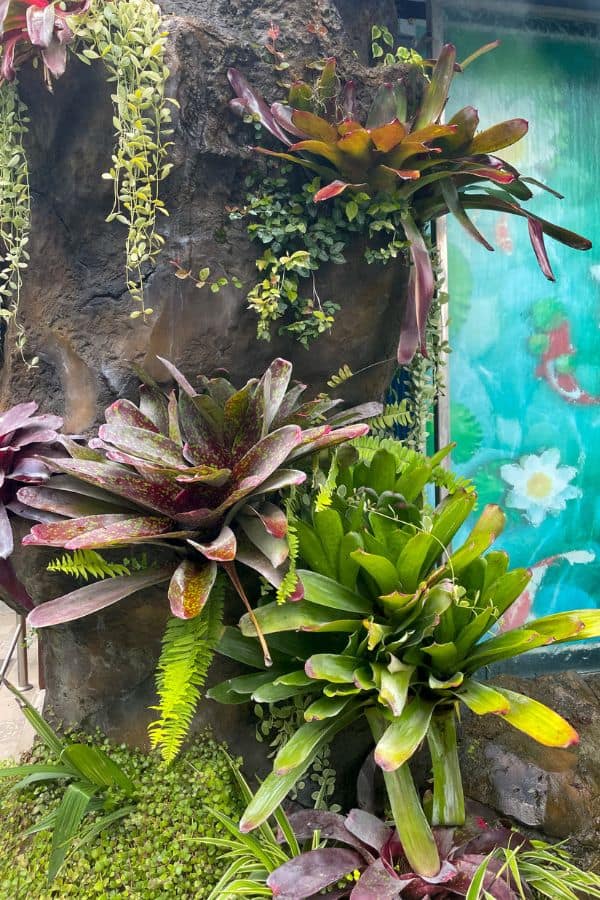
The Bromeliad genus has long been popular in the herpetoculture community.
I mean, what’s not to love? It’s a genus full to the brim with exotic plants in all kinds of wonderful colors and shapes.
Take Neoregelia, for example. These vividly colored epiphytic rosettes are absolutely stunning and endlessly versatile. They can be easily slotted into vivarium backgrounds and into the crooks of hardscape branches.
Plus, the rosettes can act like little natural cups that tiny arboreal lizards and dart frogs can enjoy chilling out in (and sometimes getting a drink from inside them).
Then, there are also the Crypanthus Earth Stars which are similar terrestrial plants with sharper star-like leaves. And finally, the Tillandsia Air Plants.
Air Plants are also epiphytic, but rather than rosettes they have unique tendril-like leaves that spill out in random directions. Super weird, and super cool.
4. Aluminum Plant (Pilea cadierei)
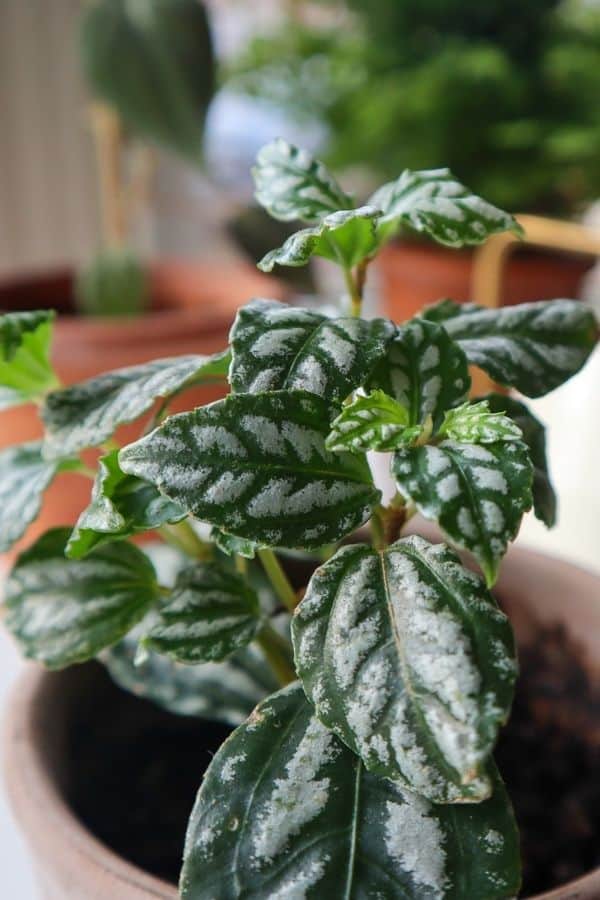
The Aluminum Plant is a bold and beautiful addition to any reptile terrarium.
Named for its characteristic silver variegation that’s splashed against a dark green leafy backdrop. Pilea cadierei is a wonderful combination of natural and unusual colors.
Honestly, they’re really easy to care for, and they’ll quickly grow in a shrub-like growth pattern.
If you’re looking for something similar in completely natural colors, check out the warm reddish hue of Pilea involucrata (Friendship Plant) or the lime green Pilea mollis (Moon Valley Pilea).
Also, don’t overlook the genus when it comes to vines too. Pilea depressa is an amazing plant to add some wild growth to a naturalistic setup.
5. Sphagnum Moss
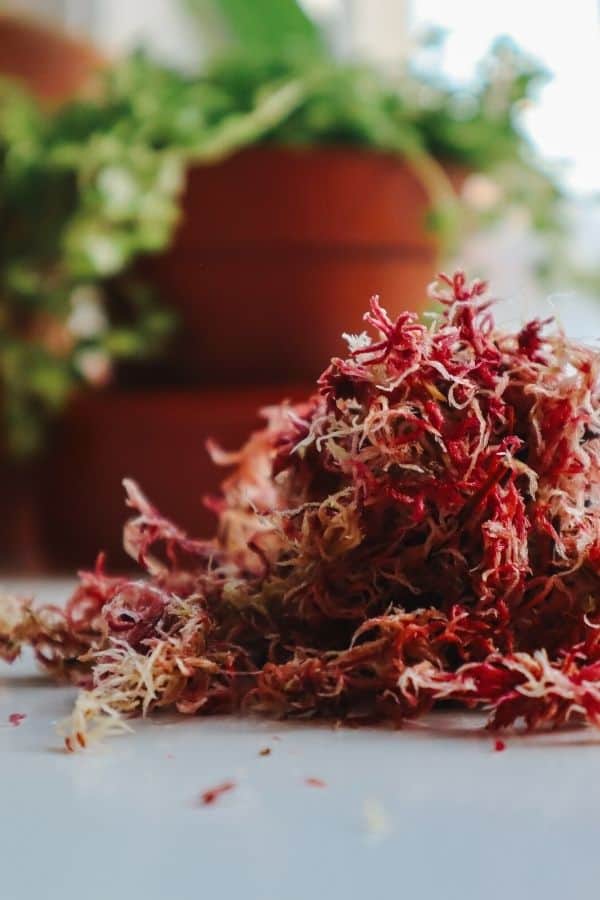
Sphagnum Moss is one of the most versatile terrarium plants/materials, so it’s no surprise that it’s made it onto this list.
Whether it’s used as a carpeting plant to form a thick mossy mat, an epiphyte growing pouch, or even a water-retentive substrate element – Sphagnum Moss brings a lot to the table.
And it’s safe for reptiles to eat, so that’s the icing on the cake, right?
6. Nerve Plants (Fittonia)
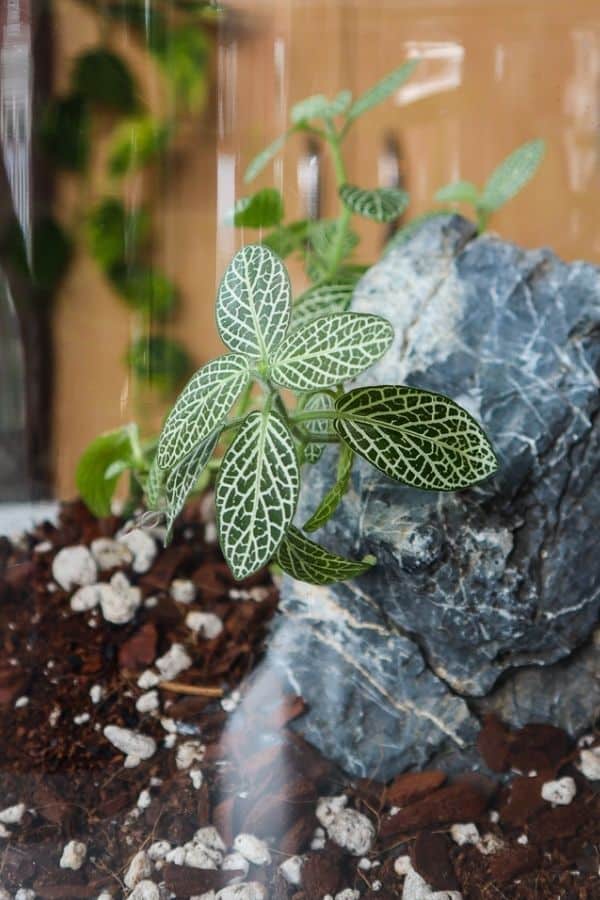
Fittonia are a classic terrarium plant.
With their deeply colored venation and unique patterns, they’re a fantastic way to brighten up any reptile terrarium.
They also grow in a shrub-like way, and you can encourage them to thicken up further by pinching off stems at the top.
Check out the Polka Dot Plant, too, for more ornate foliage plants.
7. Inchplant (Tradescantia zebrina)
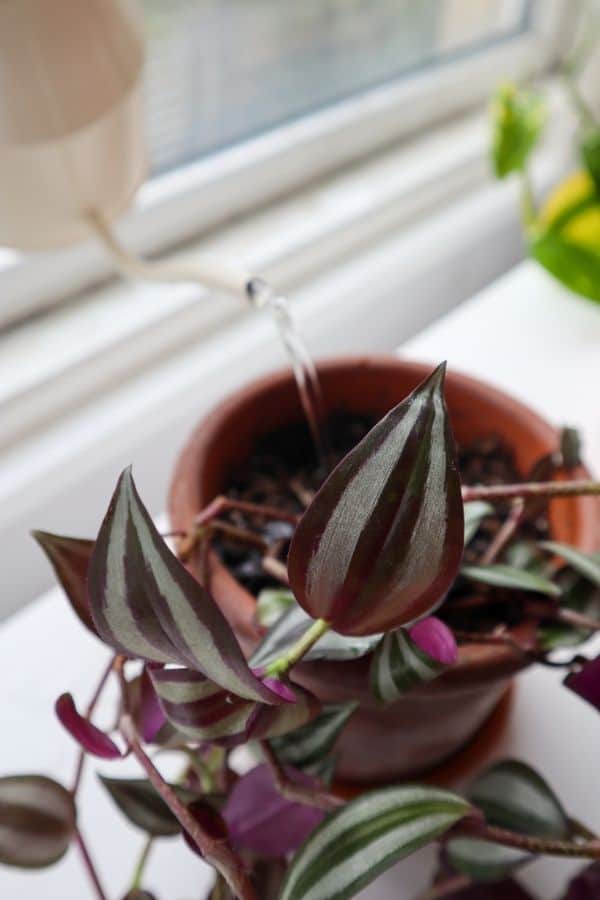
Tradescantia zebrina is a real showstopper and an insane grower.
This bright violet vine is a hardy plant that thrives in tropical terrarium conditions. You can use it as a hanging plant, or with its angular growth pattern, it can even form a dense undergrowth (full of great hiding spots).
It’ll certainly need trimming from time to time, but this plant is the gift that keeps on giving!
8. Rattlesnake Plant (Calathea lancifolia)
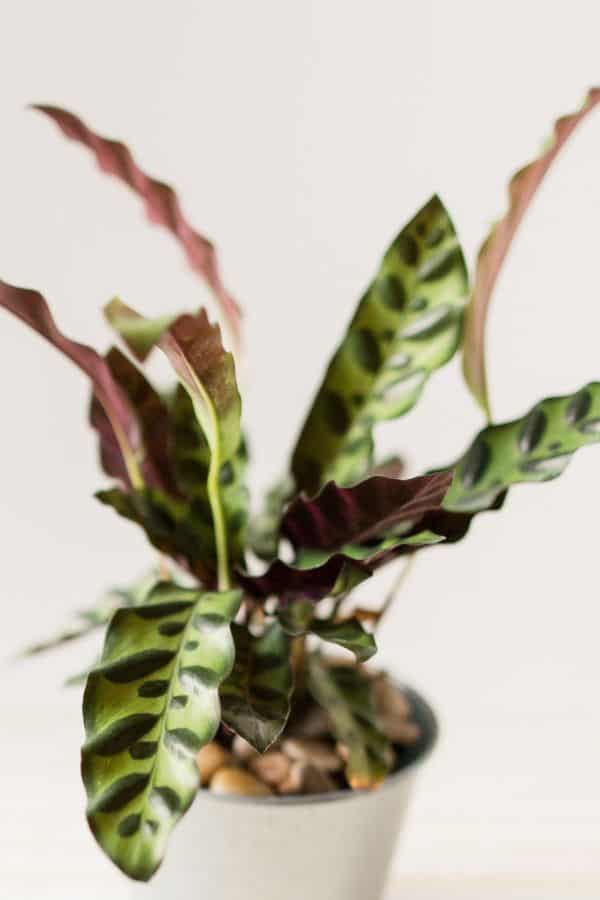
The Rattlesnake Plant is a vibrant tropical wonder
With unique lance-shaped leaves in (you guessed it) the shape and patterns of a rattlesnake’s tail, it’s a fitting plant for a reptile enclosure, don’t you think?
Though Calathea lancifolia can be tricky to grow in the home, it’ll thrive in a hot and humid environment.
9. Peperomia caperata ‘Rosso’
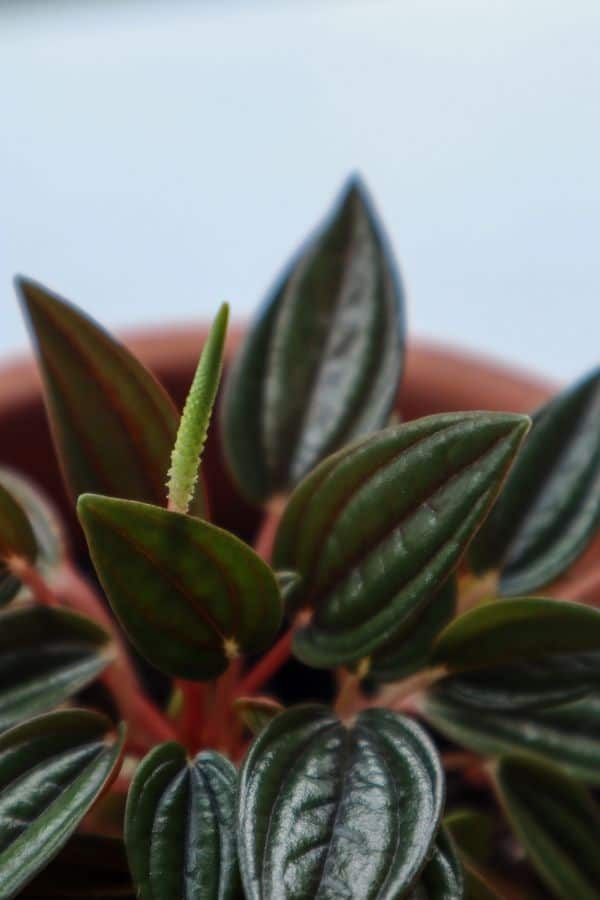
Peperomia are a diverse and often overlooked genus.
But in the terrarium world, they’re almost universally suited.
If you’re looking for compact plants that are bursting with color and character, look no further than the Peperomia Rosso. The dark green leaves and crimson undersides contrast wonderfully.
Peperomia albovittata ‘Piccolo Banda’ (the Peacock Peperomia) is another fantastic choice.
10. Herringbone Plant (Maranta leuconeura)
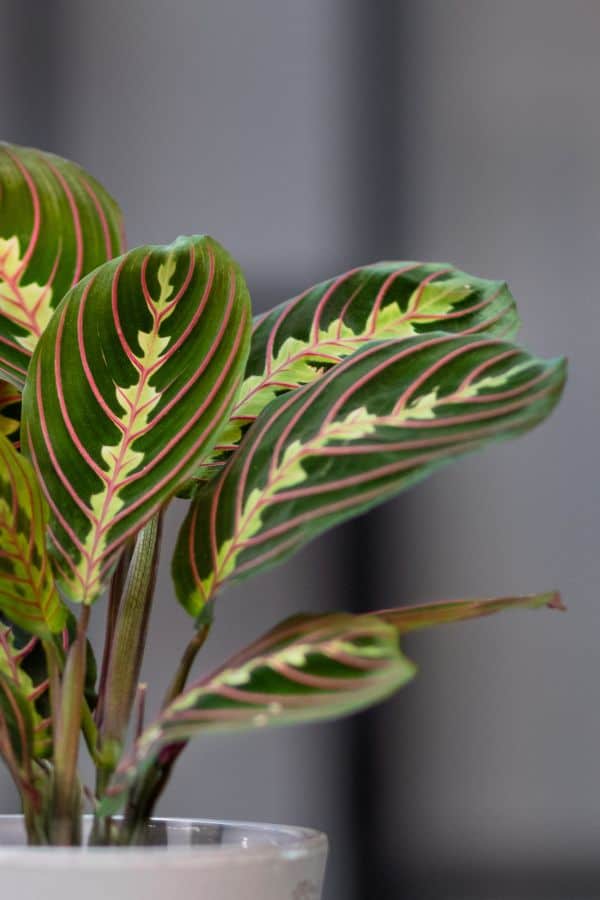
Last but by no means least, we have another prayer plant to add to the mix.
Maranta leuconeura has lovely rounded leaves with a distinctive pink herringbone pattern (like the actual fish than the weave).
Perfect to add an exotic touch to a tropical setup.
Where to Find Reptile Safe Plants for Sale
Choosing the right plant species is the first step, but there’s more to reptile safe plants than just their toxicity.
There are also things to consider based on how they’re grown.
After all, various pesticides and insecticides used in terrarium plant cultivation can be harmful to reptiles, and you don’t want to bring any of that into your tank. So, it’s worth looking out for brands that grow plants for animal use.
Glass Box Tropicals are one good example. They specialize in live plants for frog terrariums, so you can be sure they hold their plants to a high standard.
(That said, there’s a wide variety of tropical vivarium plants for sale, so whether you need live plants for a bioactive terrarium or a whole vivarium plant kit – you’re covered).
Josh’s Frogs are another great source, and they provide a good range of desert terrarium plants, too.
Wherever you source your plants, it’s always a good idea to clean and quarantine them before adding them to an enclosure – just to be extra safe.
Over to You
Choosing suitably safe plants for reptiles can be a daunting task.
There’s a lot of conflicting information online (which made this article very difficult), and it’s clearly important to get right! That’s why I’ve chosen to play it extra safe and combine data from several respected references.
Hopefully, this has made things a little easier and at least steered you towards real plants over artificial plants.
What are your favorite reptile safe plants? Let me know in the comments!
👉 Heading vivarium supplies shopping? Check out our online store.
